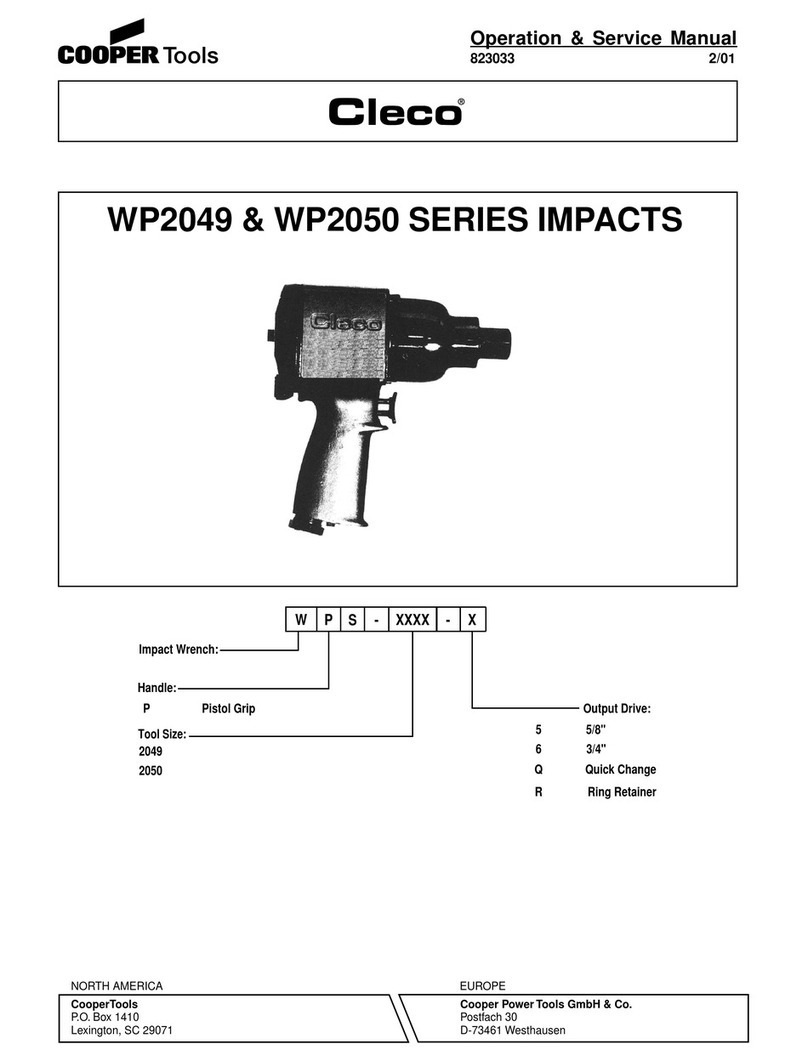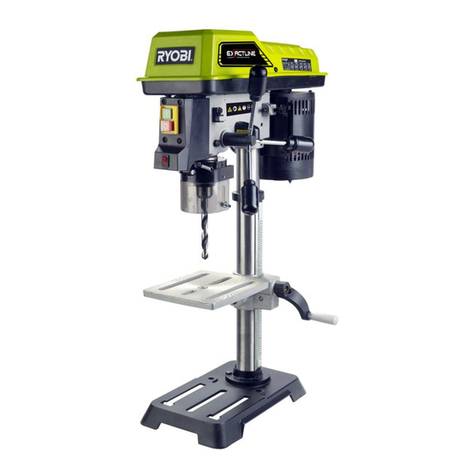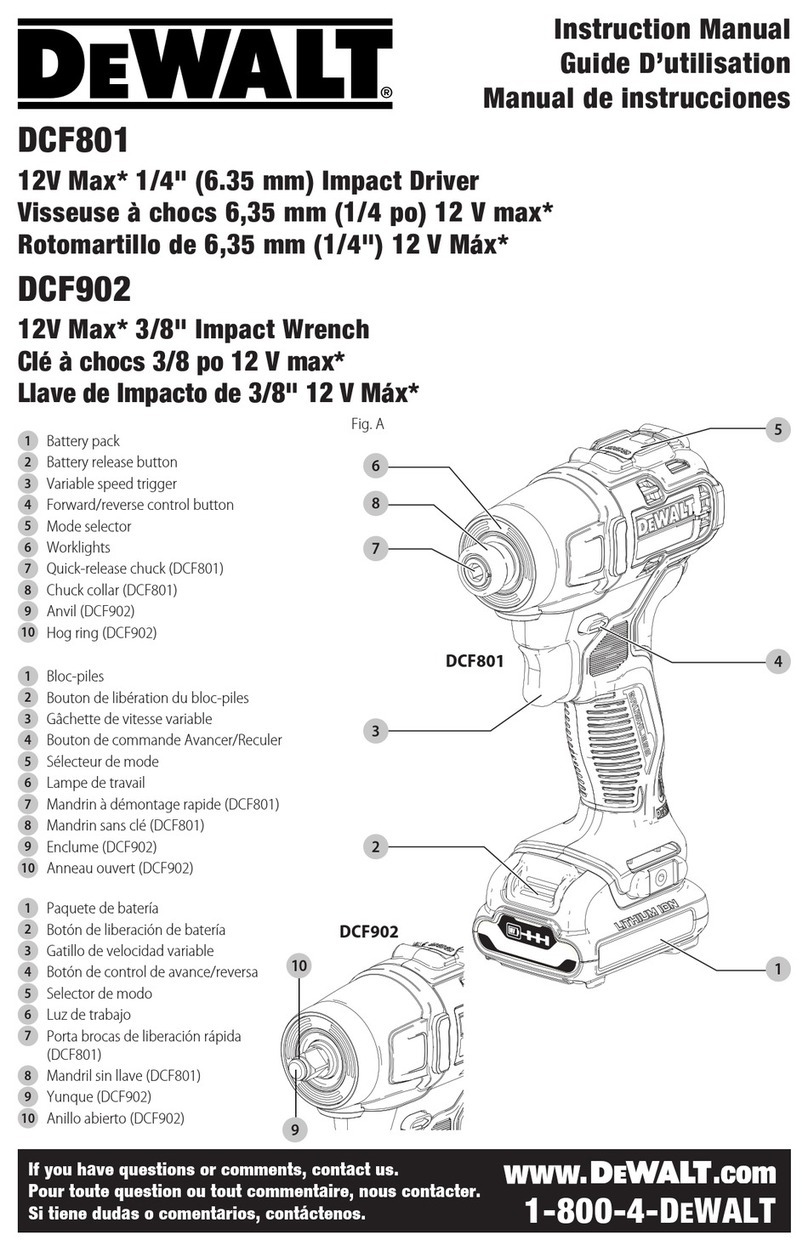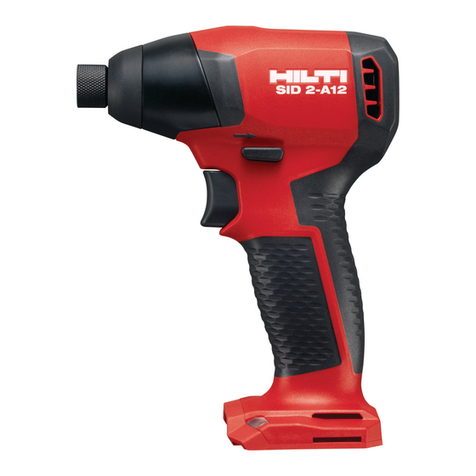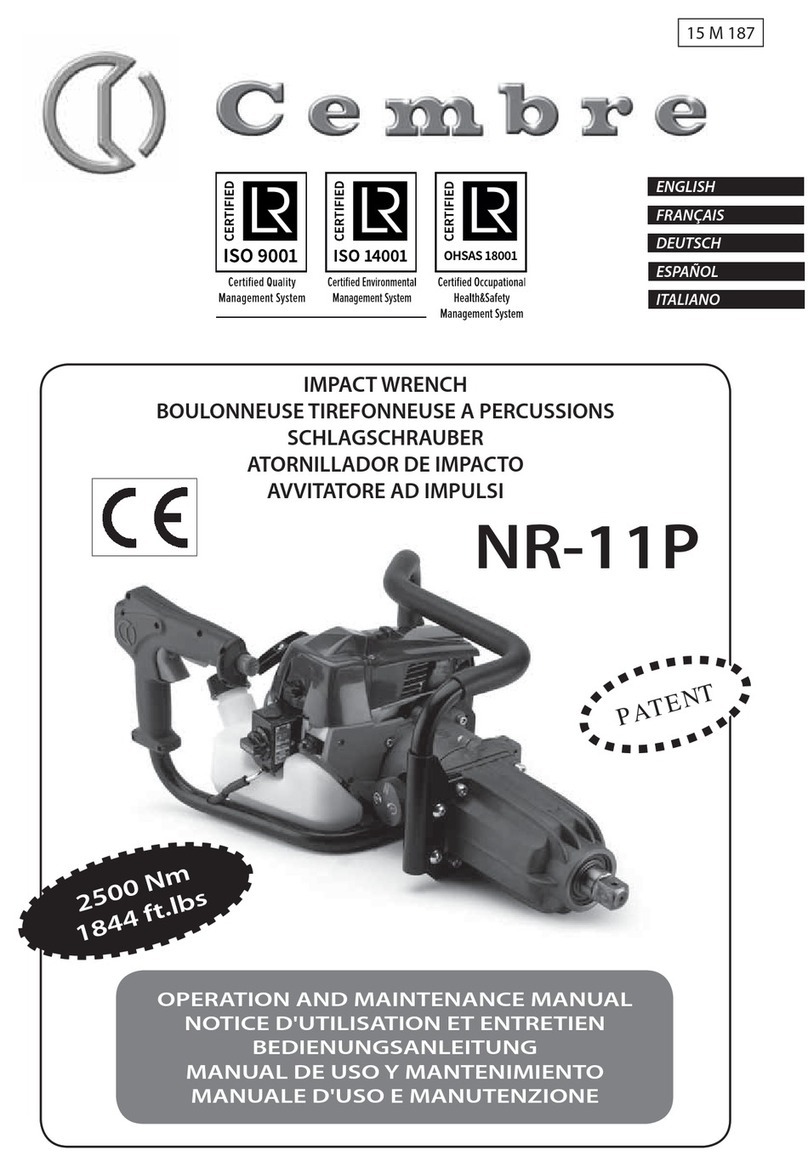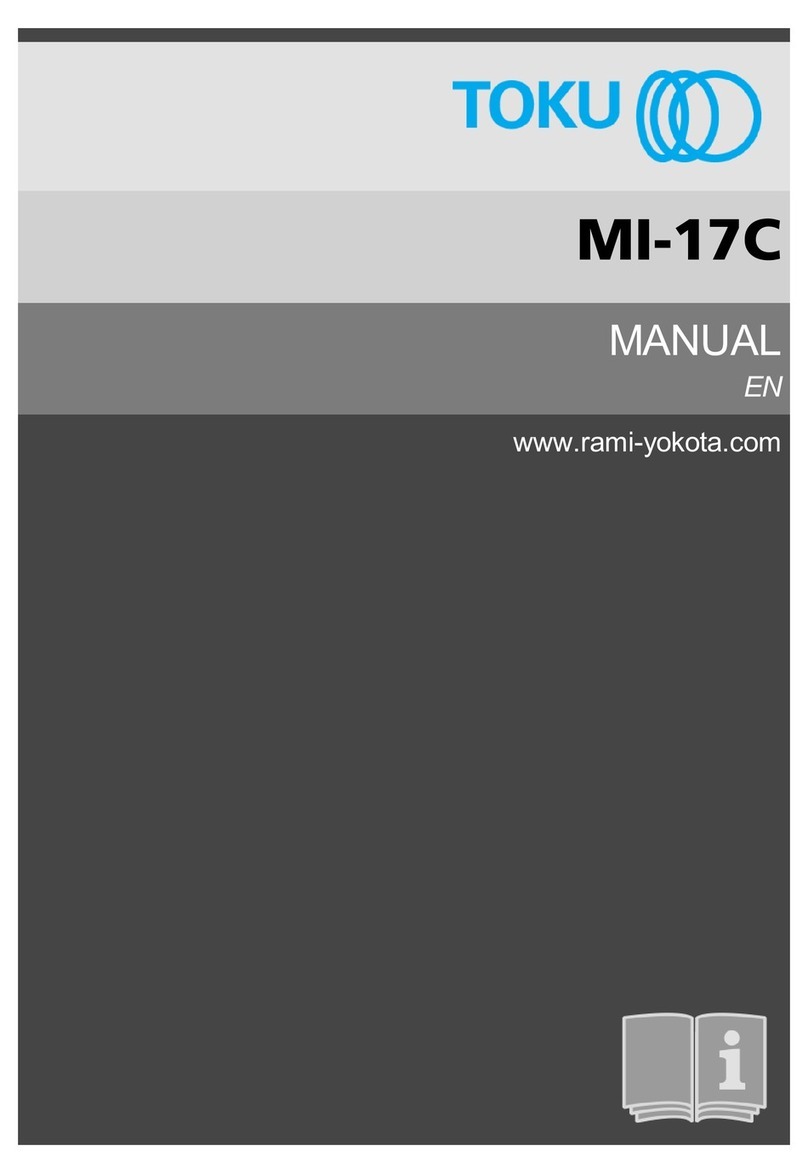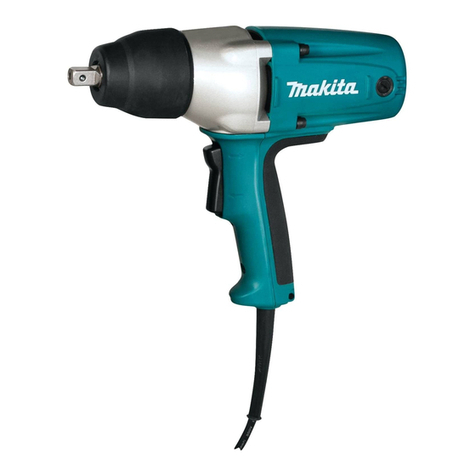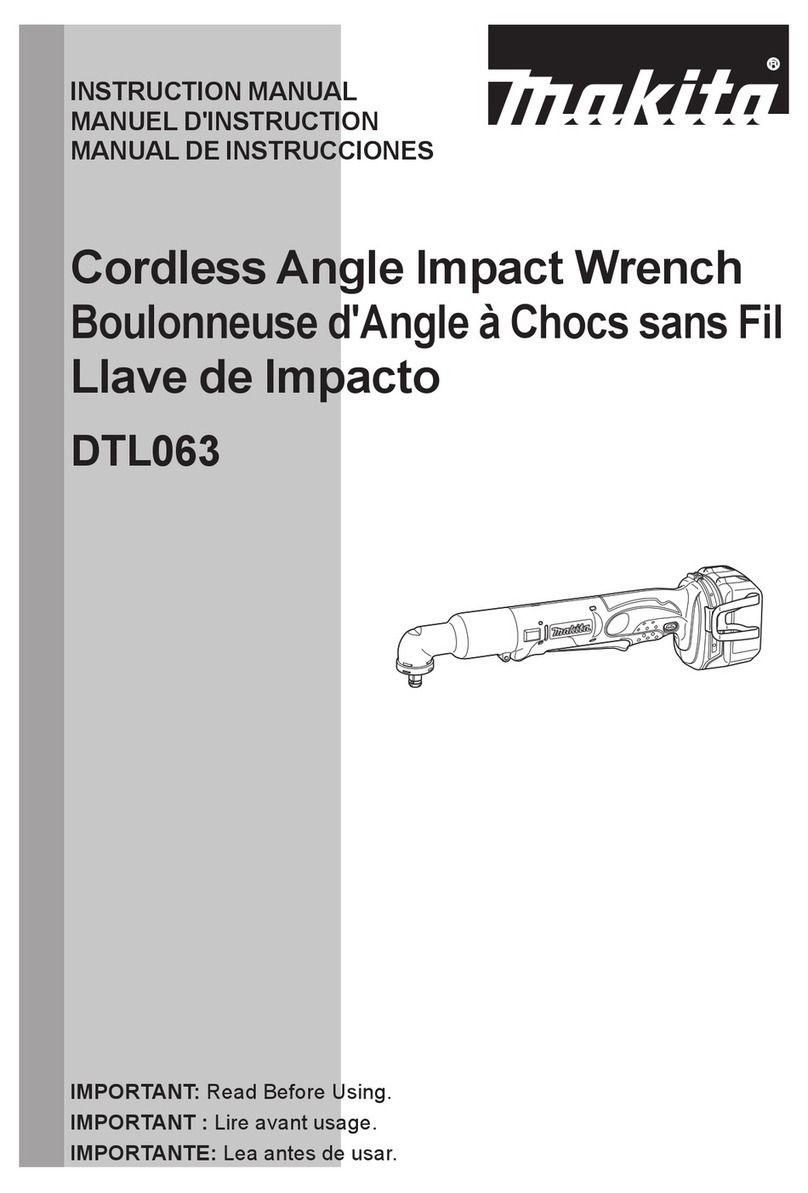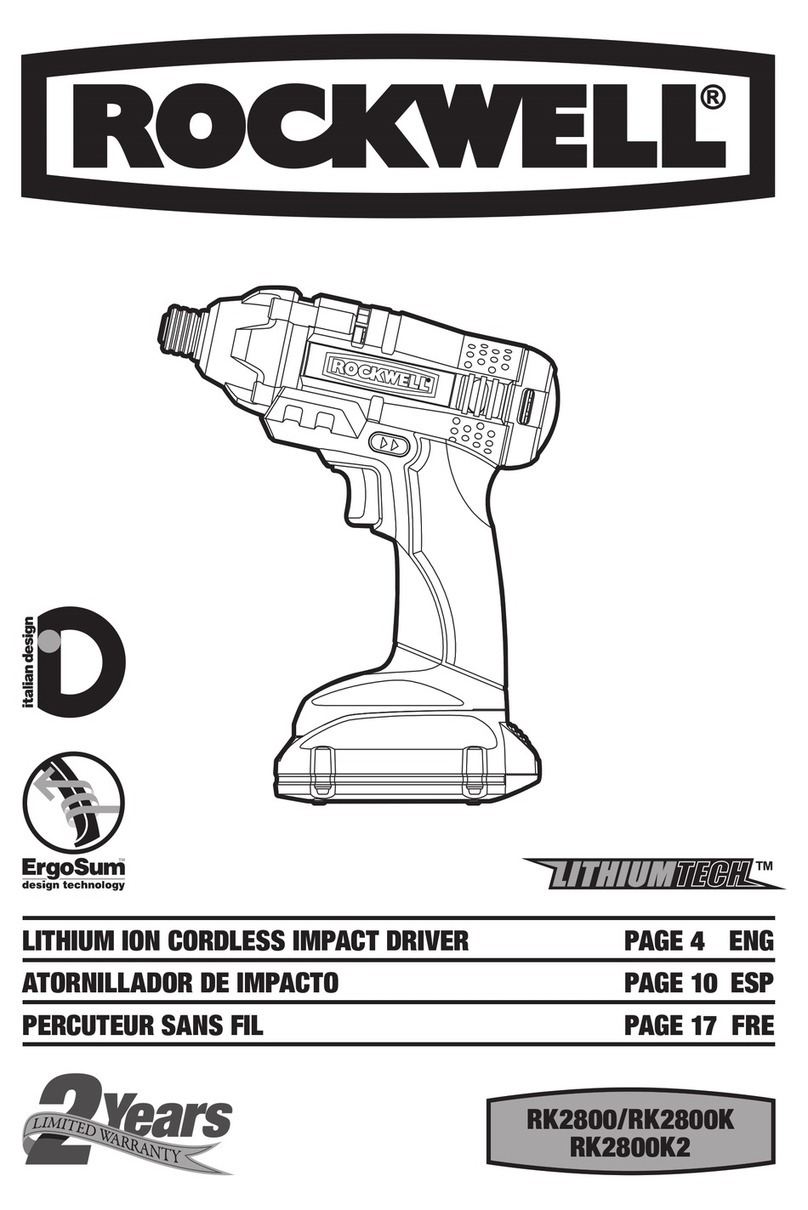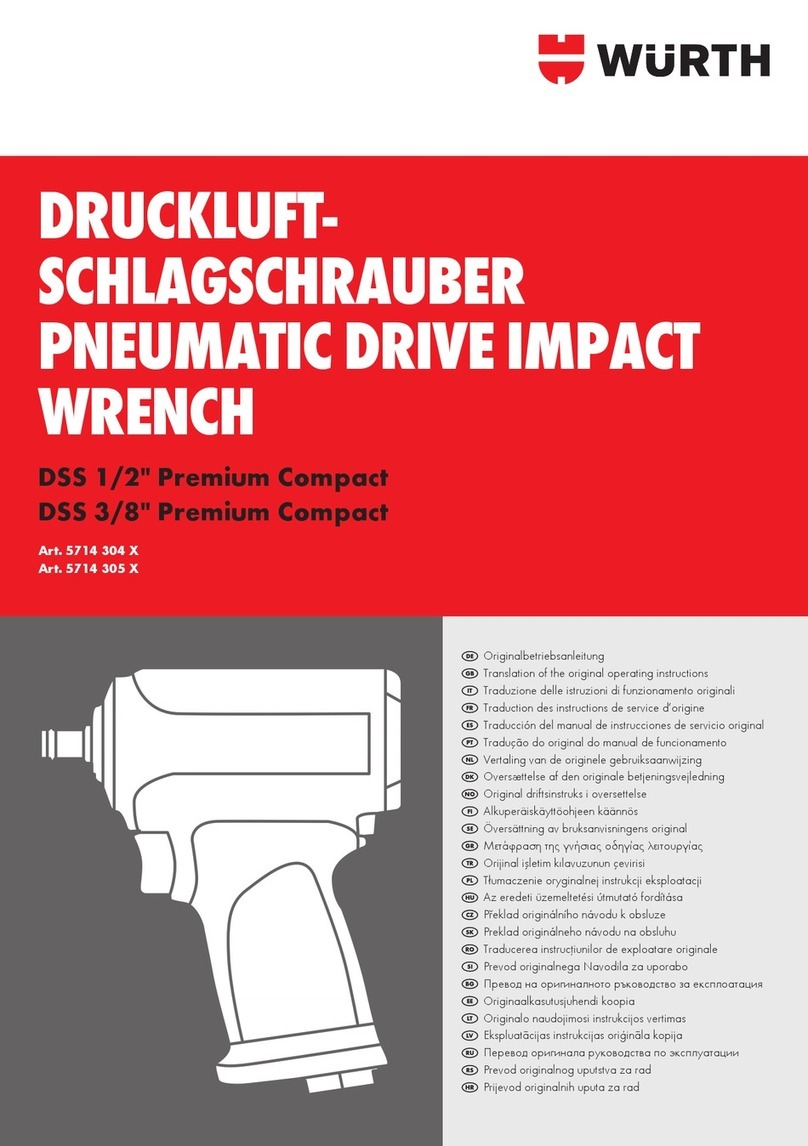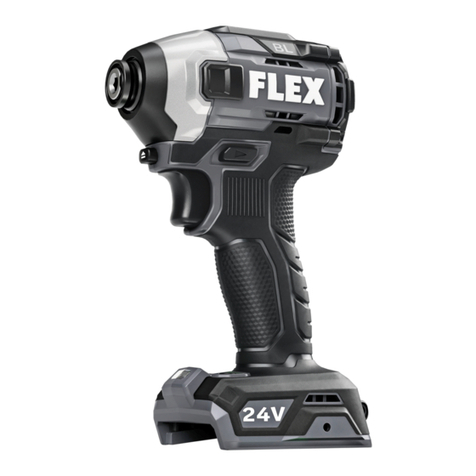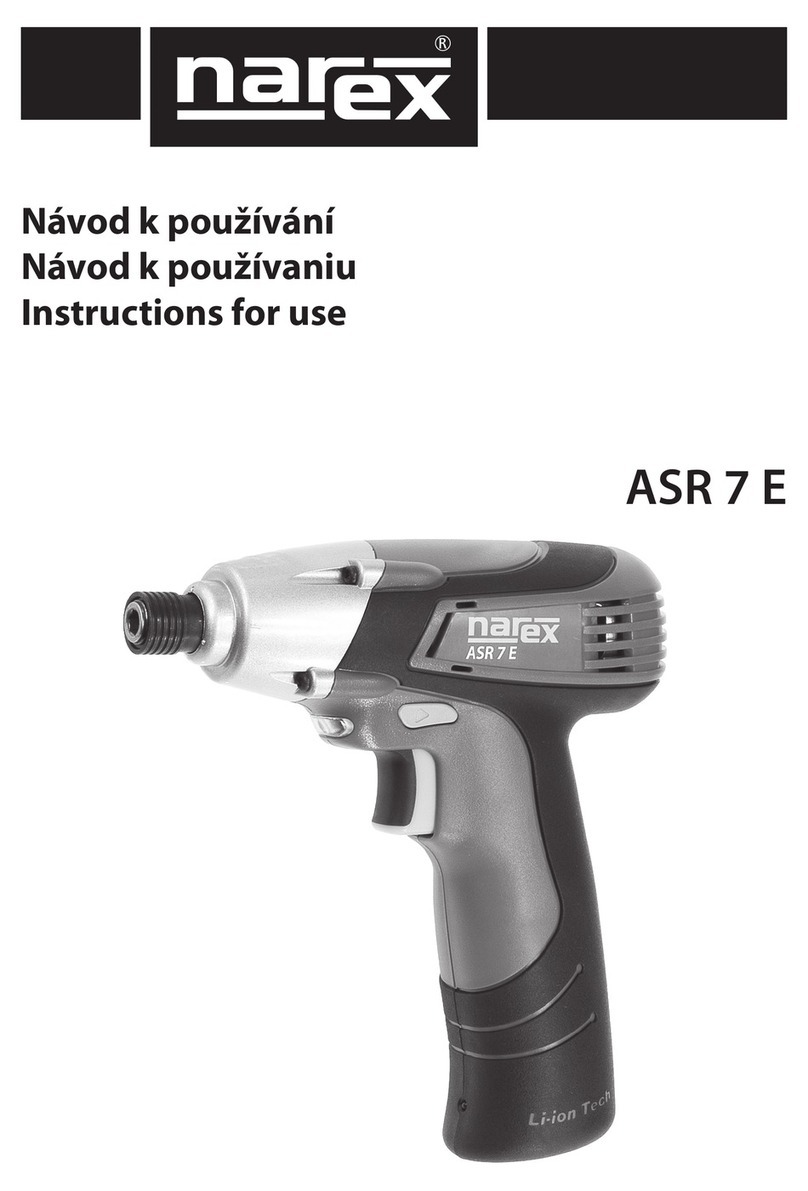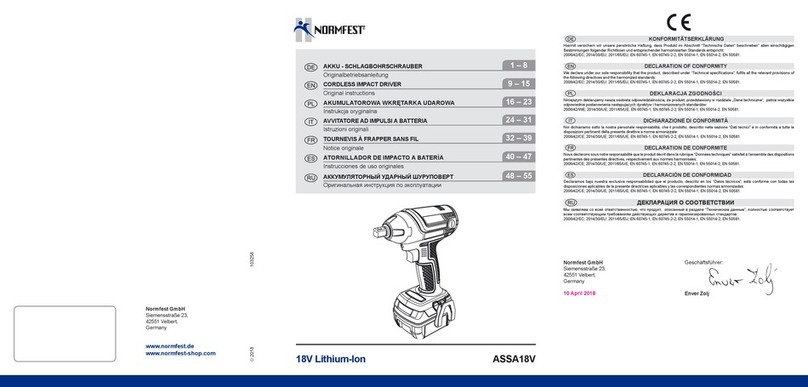Cleco WP-2060B SERIES IMPACTS Installation and operating instructions

1
Operation & Service Manual
823034 2/01
WP-2059 & 2060B SERIES IMPACTS
-
Concept
Second
B
Tool Generation:
2059 & 2060
Tool Size:
W
Pistol Grip
Impact Wrench:
P
Handle:
-- XXXXXPXX
Spline Drive (No. 5 Spline)
Quick Change
S
Q
*8 1"
Optional Equipment:
6" Extended Spindle
*6E 3" Extended Spindle
*3E
Output Drive:
*6 3/4"
XX
NORTH AMERICA EUROPE
CooperTools
P.O. Box 1410
Lexington, SC 29071
Cooper PowerTools GmbH & Co.
Postfach 30
D-73461 Westhausen

2
SafetyRecommendations
hoseofaccumulateddustandmoisture.Beforeremovingatoolfrom
service or changing sockets, make sure the air line is shut off and
drained of air. This will prevent the tool from operating if the throttle
is accidently engaged.
Neverusetheairhoseforsupporting,lifting,orloweringthetool.Use
a safety line or cable on the tool when working in elevated areas.
Tools with exposed throttles should not be used where obstructions
canhold thethrottle inthe “on”position. Animpact wrenchoperating
in reverse will move backwards as a nut is removed and can trap an
operator's hand, making it difficult to release an outside trigger.
Inside trigger or pistol grip tools are advised for close quarter
operation.
Onlyusesocketsdesignedforusewithimpactwrenches.Never use
a hand tool socket on an impact wrench. Hand tool sockets can
break, resulting in a hazard from flying pieces. Inspect sockets,
retainers, and drives regularly for wear or damage, and replace as
necessary. Worn sockets reduce power, cause drive wear, and
increase the chance for breakage and should not be used.
Some individuals may be susceptible to disorders of the hands and
arms when performing tasks consisting of highly repetitive motions
and/orexposuretoextendedvibration.Cumulativetraumadisorders
such as carpal tunnel syndrome and tendonitis may be caused or
aggravated by repetitious, forceful exertions of the hands and arms.
Vibrationmay contributeto acondition calledRaynaud'sSyndrome.
These disorders develop gradually over periods of weeks, months,
and years. It is presently unknown to what extent exposure to
vibrations or repetitive motions may contribute to the disorders.
Hereditary factors, vascular or circulatory problems, exposure to
coldanddampness,diet,smoking andwork practicesarethoughtto
contribute to the conditions.
For your safety and the safety of others, read and understand the
safety recommendations before operating an impact wrench.
Always wear protective equipment and clothing.
For additional infor-
mation on eye pro-
tection,refer toFed-
eral OSHA Regula-
tions, 29 CFR, Sec-
tion 1910.133, Eye
andFaceProtection,
and ANSI Z87.1, Occupational and Educational Eye and Face
Protection. This standard is available from the American National
StandardsInstitute,Inc.,11West42ndStreet,NewYork,NY10036.
Hearingprotectionis
recommended in
high noise areas
(above 85 dBA).
Close proximity of
additional tools, re-
flective surfaces,
process noises, and resonant structures can substantially contrib-
ute to the sound level experienced by the operator. Proper hearing
conservation measures, including annual audiograms and training
in the use and fit of hearing protection devices may be necessary.
For additional information on hearing protection, refer to Federal
OSHA Regulations, 29 CFR, Section 1910.95, Occupational Noise
Exposure, and American National Standards Institute, ANSI S12.6,
Hearing Protectors.
• Gloves and other protective clothing should be worn as
required, unless they create a greater hazard.
• Do not wear loose fitting clothing, or clothing that may
restrict movement, become entangled or in any way
interfere with the safe operation of the impact.
Clecoimpactwrenches are designedtooperate on 90 psig(6.2 bar)
maximum air pressure. If the tool is properly sized and applied,
higher air pressure is unnecessary. Excessive air pressure in-
creases the loads and stresses on the tool parts, sockets, and
fasteners and may result in breakage. Installation of a filter-regula-
tor-lubricator in the air supply line ahead of the tool is highly
recommended.
Before the tool is connected to the air supply, check the throttle for
proper operation (i.e., throttle moves freely and returns to closed
position). Being careful not endanger adjacent personnel, clear air
Repetitive work motions and/or vibration
may cause injury to hands and arms.
Use minimum hand grip force consistent
with proper control and safe operation.
Keep body and hands warm and dry.
Avoid anything that inhibits blood circulation.
Avoid continuous vibration exposure.
Keep wrists straight.
WARNING
!
Avoid repeated bending of wrists and hands.
CAUTION!
Personal hearing protection is
recommended when operating
or working near this tool.
WARNING!
Impact resistant eye protection
must be worn while operating
or working near this tool.

3
SafetyRecommendations
widely in design, material, vibration reduction, and wrist support
qualities, it is recommended that the glove manufacturer be con-
sulted for gloves designed for your specific application. WARNING!
Proper fit of gloves is important. Improperly fitted gloves may
restrict blood flow to the fingers and can substantially reduce
grip strength.
Also note that various tool wraps are available from a number of
different manufacturers. Like gloves, these wraps are also intended
to reduce and moderate the effects of extended vibration exposure.
They vary widely in design, material, thickness, vibration reduction,
effectiveness, and durability, so consideration must be given to
choosing the proper wrap for the specific application.
Thisinformationisacompilationofgeneralsafetypracticesobtained
from various sources available at the date of production. However,
our company does not represent that every acceptable safety
practice is offered herein, or that abnormal or unusual circum-
stancesmaynotwarrantorrequireadditionalprocedures.Yourwork
may require additional specific safety procedures. Follow these
procedures as required by your company.
Warnings
The warnings found on these tools are an essential part of the
product. Warnings should be checked periodically for legibility.
Replace warnings when missing or when the information can no
longer be read. Replacements can be ordered as any spare part.
869976
For more information, see the latest edition of ANSI B186.1,
SafetyCodefor Portable AirTools,availablefrom the American
National Standards Institute, Inc., 11 West 42nd Street, New
York, NY 10036.
These operating instructions and service manual should ac-
companytoolifitissubsequentlysoldorownershipischanged.
Tool operators should be aware of the following warning signs and
symptoms so that a problem can be addressed before it becomes a
debilitating injury. Any user suffering prolonged symptoms of tin-
gling, numbness, blanching of fingers, clumsiness or weakened
grip, nocturnal pain in the hand, or any other disorder of the
shoulders, arms, wrists, or fingers is advised to consult a physician.
If it is determined that the symptoms are job related or aggravated
by movements and postures dictated by the job design, it may be
necessary for the employer to take steps to prevent further occur-
rences.Thesestepsmight include, but are not limited to,reposition-
ing the workpiece or redesigning the workstation, reassigning work-
erstootherjobs,rotatingjobs,changingworkpace,and/orchanging
the type of tool used so as to minimize stress on the operator. Some
tasks may require more than one type of tool to obtain the optimum
operator/tool/task relationship.
• Tasks should be performed in such a manner that the
wrists are maintained in a neutral position, which is not
flexed, hyperextended, or turned side to side.
• Stressful postures should be avoided. Select a tool appropri-
ate for the job and work location.
The following suggestions will help reduce or moderate the effects
of repetitive work motions and/or extended vibration exposure.
•Use a minimum hand grip force consistent with proper
control and safe operation
•Keep body and hands warm and dry
•Avoid anything that inhibits blood circulation
—Smoking Tobacco
—Cold Temperatures
—Certain Drugs
•Keep wrists as straight as possible
•Avoid highly repetitive movements of hands and wrists,
and continuous vibration exposure
Work gloves with vibration reducing liners and wrist supports are
availablefromsome manufacturers of industrial workgloves.These
glovesaredesigned toreduceandmoderatetheeffectsofextended
vibration exposure and repetitive wrist trauma. Since they vary
OVER
CAUTION!
Personal hearing protection is
recommended when operating
or working near this tool.
WARNING!
Impact resistant eye protection
must be worn while operating
or working near this tool.
Read Operating Instructions carefully. Follow
the Safety Recommendations for your safety
and the safety of others.
Hearing protection is recommended in high noise
areas (above 85 dBA). Close proximity of other
tools, reflective surfaces, process noises, and
resonant structures can substantially contribute
to the sound level experienced by the user.
WARNING
!
Repetitive work motions and/or vibration
can cause injury to hands and arms.
Use minimum hand grip force consistent with
proper control and safe operation.
Keep body and hands warm and dry.
Avoid anything that inhibits blood circulation.
Avoid continuous vibration exposure.
Keep wrists straight.
Avoid repeated bending of wrists and hands.
Do not remove this tag until
the operator of this tool has
read these safety precautions.
BAD POSTURE
GOOD POSTURE

4
OPERATION
This tool is designed to operate on 90 psig (6.2 bar) air pressure,
measured at the tool's air inlet with the tool running, using a 3/8"
(10 mm) hose up to 8' (2.5m) in length. Installation of an auto-
matic in-line filter-regulator- lubricator is highly recommended to
supply the tool with clean lubricated air. This will keep the tool in
sustained operation and increase its service life.
The air hose should be cleared of accumulated dirt and moisture,
then 1 teaspoon (5ml) of 10W machine oil should be poured into
the tool's air inlet before connecting the hose to the tool.
IMPORTANT: If a quick-disconnect coupling is used with the tool.
it should be separated from the tool by a whip hose.
All tools and hoses should be installed by trained competent per-
sonnel. Hoses and fittings should be inspected regularly for wear
or damage and replaced if necessary.
The correct socket retainer should always be used on your tool.
Tools equipped with a square drive commonly use an "O"-ring
and pin for a socket retention. Tools equipped with a spline drive
have an integral socket retainer pin, and a screwdriver or similar
tool is used to depress the socket retainer plunger to either install
or remove the socket. Always use the socket retainer compo-
nents recommended by the socket manufacturer. Never substi-
tute wire, nails, or welding rods for retaining pins. Always use
sockets designed for impact wrench service.
The air supply to the tool should always be off when changing
sockets.
Sockets, retainers, and drives should be inspected regularly for
wear or damaged parts and the parts should be replaced if nec-
essary.
LUBRICATION
An automatic in-line filter-lubricator is recommended as it in-
creases tool life and keeps the tool in sustained operation. The
inlinelubricatorshould be regularlycheckedand filled with agood
grade of 10W machine oil. Proper adjustment of the in-line lubri-
cator is performed by placing a sheet of paper next to the ex-
haust ports and holding the throttle open approximately 30 sec-
onds. The lubricator is properly set when a light stain of oil col-
lects on the paper. Excessive amounts of oil should be avoided.
In the event an in-line lubricator is not used, the oil reservoir in
the handle should be utilized.
The oil reservoir marked "30W oil" should be checked periodi-
cally. The tool should be held with the rear of the tool up and the
two oil plugs should be removed. Fill the reservoir with 30W oil
until it comes out the other oil plug hole.
STORAGE
In the event that it becomes necessary to store the tool for an
extended period of time (overnight, weekend, etc.), it should re-
ceive a generous amount of lubrication at that time and again
when returned to service. The tool should be stored in a clean
and dry environment.
DISASSEMBLY
Loosen and remove the four (4) housing bolts. This will allow the
anvil housing and impact mechanism to be removed from the
front of the motor housing. The motor unit may now be slipped
out the rear of the motor housing.
Remove the anvil and anvil timing pin from the front of the cam
shaft. Clamp the hammer in a soft-jawed vise with the spring cap
up. Depress the spring cap and remove the two (2) spring keep-
ers. This will allow the cam shaft and related components to be
removed from the rear of the hammer.
Slip the two (2) bearing plates off the rotor and remove the cylin-
der and six (6) rotor blades.
Unscrewing the air inlet bushing will allow the throttle valve to be
removed for inspection of the throttle valve seal. Remove the air
inlet screen for cleaning and inspection. The throttle valve bush-
ing may be removed by drilling and tapping a 1/4-20 N.C. thread
and using a 1/4-20 bolt to remove the bushing.
REASSEMBLY
All parts should be cleaned in a solvent and inspected for wear or
damage. If rotor blades measure less than 11/32" (8.7mm) on
either end they should be replaced. Replace blade if less than
11/32" (8.7mm) on either end.
Rotor bearings should be replaced if they feel rough or show ex-
cessive looseness. Rotor shaft seals and the anvil seal should
be replaced if they are badly worn or are no longer flexible .
IMPORTANT NOTE: During reassembly of the WP-2059 motor,
the blue coded bearing plate, No. 869745, is assembled to the
rear of the motor. During reassembly of the WP-2060B motor,
the blue coded bearing plate, No. 869745, is assembled to the
front of the motor.
Clean the bearing plates and anvil housing with a solvent and
coat the seal bores with " PERMATEX "Aviation Form-a-gasket
#3H. Allow to air dry at least four (4) minutes before pressing in
the seals. Press the rotor shaft seals into the bearing plates with
their "lips" facing outward (visible after assembly). Press the an-
vil seal into the anvil housing with its "lip" toward the rear of the
housing ("lip" not visible after assembly).
All impact mechanism parts should receive a thin coating of 30W
oil before reassembly. Insert the cam timing pin into the recess
located on the small O.D. of the cam and then install the cam and
pin into the rear of the hammer. Slip the cam shaft through the
cam and assemble the hammer spring and spring cap to the front
of the cam shaft. Depress the spring cap and insert the two (2)
spring keepers into the groove on the cam shaft. After assembly
of the complete tool, the tool should be held with the rear of the
tool up and 1-1/4 fluid ounces (40ml) of 30W oil should be added
to 30W oil fill hole. A few drops of 10W machine oil should be
poured into the air inlet of the tool to ensure lubrication of the
motor parts as soon as air is applied.
All tools should be tested after repair or replacement of parts to
ensure that they are functioning properly.

5
The complete spline drive anvil can be purchased as a subassembly using part no 861024
PART NO.
842394
861739
863589
863591
865779
867949
867950
867957
869361
869362
869363
869364
869365
869366
869367
869368
869369
869370
PART NO.
869371
869375
869376
869381
869382
869384
869385
869386
869387
869388
869389
869392
869393
869398
869399
869400
869402
869403
869412
NAME OF PART
Retainer Ring
Anvil Housing (incl. 869376, 869392, 869393)
15/32" Steel Ball
Collar Spring
Anvil Timing Pin
Socket Retainer Spring
Socket Retainer Plunger
Socket Retainer Pin
Hammer
3/4" Sq. Dr. Anvil
3/4" Sq. Dr. Anvil - 3" Extended
3/4" Sq. Dr. Anvil - 6" Extended
1" Sq. Dr. Anvil
1" Sq. Dr. Anvil - 3" Extended
1" Sq. Dr. Anvil - 6" Extended
Cam Shaft
Cam
Cam Roller
NAME OF PART
Cam Timing Pin
Spring Cap
Anvil Bushing
Gasket
Hammer Spring
Cam Roller Shaft
Retainer Sleeve
Butt Plate
Insulator
Shock Absorber
Spring Keeper
Retainer Ring
Anvil Seal
Suspension Bail
Quick Change Anvil
Spline Drive Anvil
Release Collar
Spring Retainer
Housing Bolt
QTY.
1
1
1
1
1
1
1
1
1
1
1
1
1
1
1
1
1
1
QTY.
1
1
1
1
1
1
1
1
1
1
1
2
1
1
1
1
1
1
4
PARTS LIST —IMPACT MECHANISM

6
PART NO.
844287
844383
863399
844892
869311
869359
869360
869374
PART NO.
869378
869381
869394
869395
869396
869397
869738
869745
NAME OF PART
Lockwasher
Nut
O-ring
Oil Plug
Oil Plug
Cylinder
Rotor
Backcap
NAME OF PART
Rotor Blade
Gasket
Rotor Shaft Seal
O-ring 2-11/16" X 2-7/8"
Rotor Bearing
Alignment Pin
Bearing Plate (Silver)
Bearing Plate (Blue)
QTY.
1
4
4
1
1
1
1
1
QTY.
6
1
2
2
2
1
1
1
PARTS LIST —MOTOR

7
The complete Motor Housing can be purchased as a subassembly using Part No 861740
PART NO.
202470
202471
412775
842550
843590
844309
844799
845090
846170
863072
863074
PART NO.
863093
863520
863600
869372
869373
869379
869380
869390
869998
NAME OF PART
Muffler Element (Not Shown)
Muffler
Air Inlet Screen
Oil Plug
Oiler Valve
"O"-Ring 7/16" x 518"
Trigger Pin
Trigger Stop Pin
Reversing Valve Bushing
Throttle Valve Spring
Air Inlet Bushing
NAME OF PART
"O"-Ring 1" x 1-1/8"
Trigger
Throttle Valve Seal
Motor Housing (incl. 843590,
869379,844170)
Reversing Valve
Throttle Valve Bushing
Throttle Valve
Exhaust Deflector
Exhaust Deflector Screw
QTY.
1
1
1
1
1
1
1
1
1
1
1
QTY.
1
1
1
1
1
1
1
1
2
PARTS LIST —MOTOR HOUSING

8
CooperTools
670 Industrial Drive
Lexington, SC 29072
Phone: (803) 359-1200
Fax: (803) 359-2013
www.cooperindustries.com
This manual suits for next models
1
Table of contents
Other Cleco Impact Driver manuals
